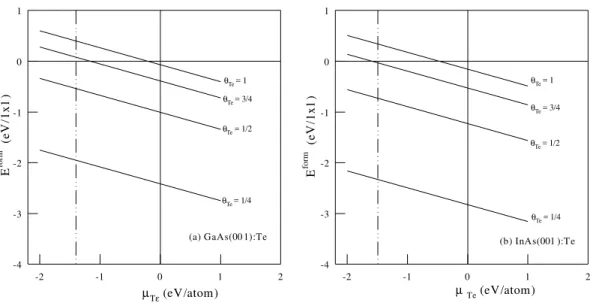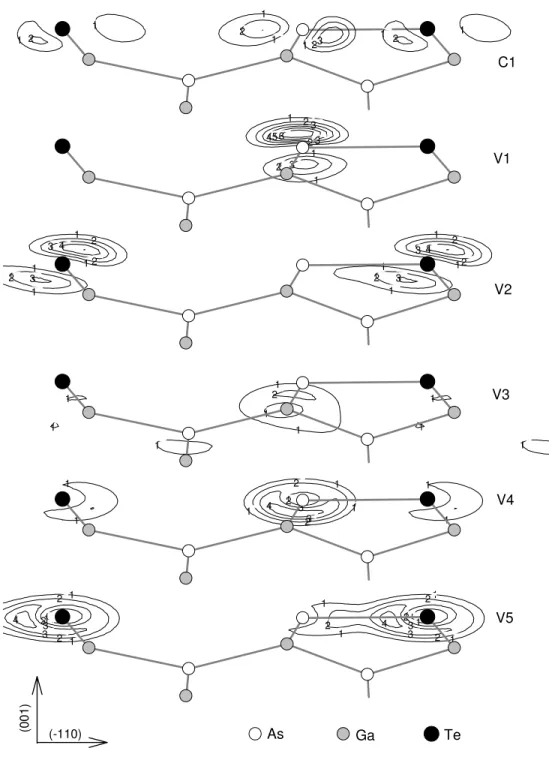Tellurium - Modied Surface States
of GaAs(001) and InAs(001)
R.Claudino da Silva
Instituto de Ci^encias, Escola Federal de Engenharia de Itajuba, C.P. 50, 37500-000 Itajuba-MG
and A. C.Ferraz
Departamento de Fsica dos Materiais, Instituto de Fsica, Universidade de S~ao Paulo, C.P.66318, 05315-970 S~ao Paulo-SP
Received February 8, 1999
We investigate the stability and electronic structure of 12 and 22 GaAs(001):Te and InAs(001):Te
surfaces with dierent degrees of tellurium coverage ( Te =
1
4 ;
1
2 ;
3
4
;1), by means of rst-principles
pseudopotential calculations within density-functional theory. The adsorption stability decreases as the tellurium coverage increases. The adsorption on InAs(001) is more stable than on GaAs(001). As-Ga (or As-In) bonds for the uppermost As atoms ares
2
p
2-like (nearly planar), while the Te bonds
at the surfaces aresp
3-like. The hetero-dimers in T
e = 1
2 modify the character of GaAs(001):Te
and InAs(001):Te surfaces resulting in a semiconductor structure.
I Introduction
There are observation [1] of the surfactant action of Te in the heteroepitaxial growth of large mismatchsystems such as InAs/GaAs by addition of Te over GaAs(001). In ref. [2] the authors propose that the 2D growth is stabilized by half a monolayer of Te atoms that remain on the interface. This model is supported by the ex-perimental indication that only the excess of half a monolayer of Te atoms oats at the InAs surface [3] and by a total energy calculation showing a reduction of the GaAs/InAs interface strain energy by a Te in-terlayer [4]. Our previous theoretical calculations with adsorbed atoms at bridge positions [5, 6] determined a pattern of atomic relaxation with dimerization in (-110) direction in agreement with experimental results [7], indicating that the GaAs(001):Te-22 (
Te= 1)
sur-face has two dimers geometries at the lowest congura-tion. Also, for the concentration (
Te = 1
2) Te atoms
prefers to be adsorbed on the sites o-chain, indicat-ing a monoatomic adsorption. We report an investiga-tion of stability and electronic structure of 12 and
22 GaAs(001):Te, Ga terminated, and InAs(001):Te,
In terminated surfaces, covered by Te and As atoms with concentration
Te= 1
4 ;
1
2 ;
3
4 and 1.
II Calculation
Our calculations to simulate the systems are based on density-functional theory within the local-density ap-proximation (DFT-LDA). We consider an articial pe-riodic slab geometry along the (001) direction. The unit cell includes an atomic slab with six atomic GaAs(001), or InAs (001) layers for Ga (or In) terminated sur-faces, covered by Te or As adlayer and a vacuum re-gion equivalent in thickness to a six layers. The dan-gling bonds on the back-side of the slab (As surface) were satured H atoms. The tree uppermost layers and surface are allowed to relax. The eletric eld result-ing from the inequivalence of the two surfaces is cor-rected by a dipole calculated self-consistently [8]. The electron-ion interaction is treated by using fully sep-arable, norm-conserving pseudopotentials [9]. For the electron-electron interaction we employ the exchange correlation potential of Ceperlay-Alder [10] as param-eterized by Perdew and Zunger [11]. Single particle orbitals are expanded into plane waves up to a cut-o energy cut-of 12 Ry. ~
k-space integrations are replaced
by a sum over eight (12 cells) or four (22 cells)
with respect to both the electronic and atomic degrees of freedom is found by means of a molecular-dynamical approach [12].
III Results and discussion
The stability of the Te and As adsorption on GaAs(001) e InAs(001) surfaces are investigated for 12 and 22
cells. To analyze the stability we consider the formation energies (grand canonical potentials) dened as [13]:
Eform= Etot,EGa (In)
,nAsAs
nTe ,Te; (1)
where Etot is the total energy of relaxed structure,
EGa(In)is the total energy for full relaxed clean surface
GaAs(InAs), nTe and nAsare the number of adsorbed
tellurium and arsenic atoms at the surface, and Teand
As the chemical potentials. This a relative formation
energy and we can take it as a function of the tellurium chemical potential, xing As from the As bulk value.
The maximumvalue for Tecorresponds to the Te bulk
elemental phase and the lower limit was taken as the chemical potencial of Te atoms adsorbed on GaAs(001) or InAs(001) surface, Ga(In)As(001)
Te :
Ga(In)As(001)
Te TebulkTe : (2)
Our calculated value for the chemical potencial of Te atoms adsorbed on the surfaces, relative to bulkTe , is
,1:40eV=atom for GaAs(001), and,1:49eV=atom for
the InAs(001). These values dene the range for the dierent coverages at the surfaces. Fig. 1 shows the formation energies with Te = 1
4; 1
2; 3
4 and 1 for
(a)GaAs(001):Te and (b)InAs(001):Te. The formation energies in units eV/1x1 surface, for the adsorptions on GaAs(001) are Eform =,3:75,Te for Te =
1
4,
Eform=,2:34,Tefor Te = 1
2, E
form=,1:72,Te
for Te = 3
4 and E
form = ,1:40,Te for a full
coverage of Te (Te = 1). We also have considered
three possible geometries for the Te = 1 2 in a 2
2
cell with Te-Te, Te-As and As-As dimers at the sur-face. As their surface energies dier by less than 0.05 eV/cell, the 12 reconstruction with hetero dimers
at the surface should be the more stable structure, in agreement with STM observations [7]. The Te fully coverage has the same formation energy for 12 and
22 reconstructions. For adsorption on InAs(001)
sur-faces, we have obtained the formation energies in units eV/1x1 surface as: Eform =,4:16,Te for Te =
1
4,
Eform=,2:56,Tefor Te = 1
2, E
form=,1:86,Te
for Te =3 4 and E
form=,1:49,Tefor a Te fully
cov-erage (Te = 1). Also here we have the same formation
energy for 12 or 22 systems. As found for GaAs,
the three geometries with Te = 1
2 present the more
stable structure with a 12 reconstruction. In Fig. 1,
we can observe that the stability decrease as the tel-lurium concentration increase at the coverage, and the adsorption on InAs(001) (Fig. 1b) is more stable than on GaAs(001) (Fig. 1a).
We veried that As-Ga (or As-In) bonds for the up-permost As atoms are s2p2-like (nearly planar) while
the Te-Ga (or Te-In) at the surfaces are sp3-like for
every coverage and reconstruction. The surface band structure presents a semi-metalic character for every coverages with Te6=
1
2, at the GaAs(001) or InAs(001).
For the Te= 1
2 concentration we veried a 1
2
recon-struction, with the hetero dimers modifying the struc-ture to a semiconductor character.
In Fig. 2 we present the electronic band structure of the 12 semiconductor surface: (a)GaAs(001):Te
and (b)InAs(001):Te. These systems have ve surface states at the hetero dimers. The surface states charge densities are plotted in Fig. 3 for GaAs that have the same behavior for InAs. The rst unoccupied state C1 (Fig. 2 and 3-a) is about 0.6 eV below the conduction band along the K,J
0
,,, K directions for GaAs and
0.8eV for InAs. This state are like. The V1 and
V2 surface states (Fig. 2 and 3-b, 3-c) are antibonding - combinations of p
z orbitals localized at As and Te
surface atoms. The V2 state is well localized around the K point and 0.44 eV above the valence band for GaAs and 0.4 eV for InAs. For GaAs(001):Te, V1 has a dispersion of 0.82 eV along J, K, J
0
,,, while
InAs(001):Te has a dispersion of 0.71 eV at the same directions. The surface state V3 (Fig. 2 and 3-d) cor-responds to the interaction between the second layer, the surface, and the third layer atoms. At the internal gap, we verify the surface state V4 with s-state com-binations localized at the As surface atoms. Finally, the V5 state at the botton of the valence band are -like, with combinations of Te and As s-orbitals at the surface. This V5 state is well localized around the K point at the surface Brillouin zone for GaAs and spread along J, K, J
0for InAs with a maximum dispersion
IV Conclusion
We observed that the adsorption stability decreases as the tellurium coverage increases. The formation ener-gies indicate that the telluriumadsorption on InAs(001) is more stable than on GaAs(001). The uppermost As atoms haves
2
p
2-like bonds while the Te at the surfaces
have sp
3-like bonds. The surface states at the
funda-mental gap are antibonding
-combinations of p
z
or-bitals localized at the surface atoms (Te or As) and
-bonding combinations of As, Te-Te dimers and As-Te hetero-dimers. The GaAs(001):As-Te and InAs(001):As-Te surfaces with
Te = 1
2 exibit a
-type surface state
below the valence band localized at the As-Te hetero-dimer. The hetero-dimers in
Te= 1
2 modify the
char-acter of GaAs(001):Te and InAs(001):Te surfaces re-sulting in a semiconductor structure.
µΤε (eV/atom)
-2 -1 0 1 2
E
fo
rm
(eV
/1
x
1
)
-4 -3 -2 -1 0 1
µTe (eV/atom)
-2 -1 0 1 2
E
fo
rm
(eV
/1
x
1
)
-4 -3 -2 -1 0 1
θTe = 1 θTe = 1
θTe = 3/4
θTe = 1/2
θTe = 1/4
θTe = 3/4
θTe = 1/2
θTe = 1/4
(a) GaAs(00 1):Te (b) InAs(001 ):Te
Figure 1. Formation energies for (a) GaAs(001):Te; and (b) InAs(001):Te.
C1
Γ J K J# Γ
-12 -10 -8 -6 -4 -2 0 2 4
_ _
_ _
_ _
(b) InAs(001):Te
V5 V4 V3
V2 V1
K
Energy (eV)
V3
Γ J K J# Γ
-12 -10 -8 -6 -4 -2 0 2 4
_ _
_ _
_ _
V5
V4 V2 V1
C1
K
Energy (eV)
(a) GaAs(001):Te
Figure 2. Electronic band structure for (a) GaAs(001):Te-(12); and (b) InAs(001):Te-(12) withT e=
1
1 1
1 1 2 2
3 3
2 45
3 6
1 1
2 2 3 4
1 1
2 3
1 1
2 2 3 4
1
1
2 3
1 1
1 1
1 2
1
1 1
1
1 1
1 1
1
2 2
3 3
4 2 1
1 1
1 1
1 1
2 2
2
2
33 1
4 1
1 2
2 2
33
1 4
1 1 2
1 23 1 1
2 1
1 2
As Ga Te
(0
01
)
(-110)
V5 V4 V3
V2 V1 C1
Figure 3. Energy-resolved charge density contour plots for the GaAs(001):Te-(12) with Te=
1
2.
Acknowledgments
The authors would like to thank CENAPAD-SP and LCCA-USP for computational support which enable this work.
References
[1] N. Grandjean, J. Massies and V. H. Etgens, Phys. Rev. Lett.64, 799 (1992).
[2] N. Grandjean and J. Massies, Phys. Rev. B53, 13231
(1996).
State. Comm.95, 873 (1995).
[4] R. H. Miwa, A. C. Ferraz, W. N. Rodrigues and H. Chacham, Surf. Sci.415, 20 (1998).
[5] A. C. Ferraz and R. Claudino da Silva, Surf. Sci. 352-354, 379 (1996).
[6] R. Claudino da Silva and A. C. Ferraz, Braz. J. Phys.
27/A, 234 (1997).
[7] D. K. Biegelsen, R. D. Bringans, J. E. Northrup and L. E. Swartz, Phys. Rev. B41, 5701 (1990).
[8] J. Neugebauer and M. Scheer, Phys. Rev. B46, 16067
(1992).
[9] X. Gonze, R. Stumpf and M. Scheer, Phys. Rev. B
44, 8503 (1991).
[10] P. M. Ceperlay and B. J. Alder, Phys. Rev. Lett.45,
566 (1980).
[11] J. P. Perdew and A. Zunger, Phys. Rev. B 23, 5048
(1981).
[12] R. Carr and M. Parrinello, Phys. Rev. Lett.55, 2471
(1985).
[13] A. Kley and J. Neugbauer, Phys. Rev. B 50, 8616

